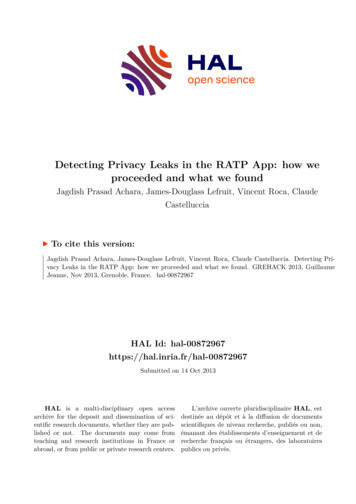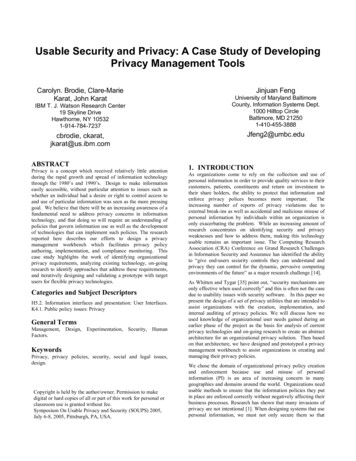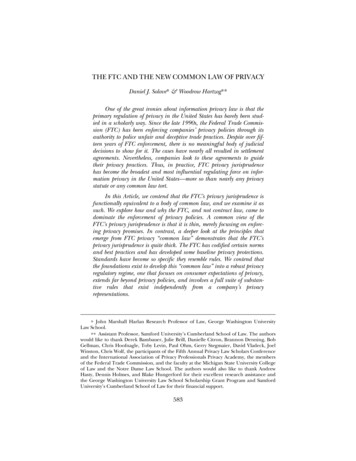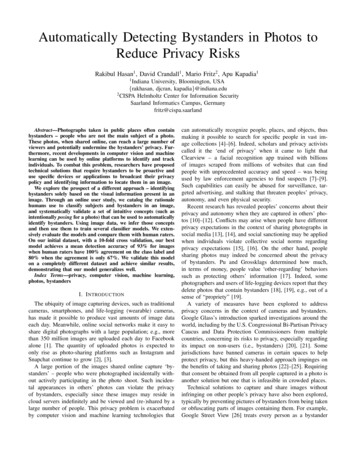
Transcription
Detecting Privacy Leaks in the RATP App: how weproceeded and what we foundJagdish Prasad Achara, James-Douglass Lefruit, Vincent Roca, ClaudeCastellucciaTo cite this version:Jagdish Prasad Achara, James-Douglass Lefruit, Vincent Roca, Claude Castelluccia. Detecting Privacy Leaks in the RATP App: how we proceeded and what we found. GREHACK 2013, GuillaumeJeanne, Nov 2013, Grenoble, France. hal-00872967 HAL Id: tted on 14 Oct 2013HAL is a multi-disciplinary open accessarchive for the deposit and dissemination of scientific research documents, whether they are published or not. The documents may come fromteaching and research institutions in France orabroad, or from public or private research centers.L’archive ouverte pluridisciplinaire HAL, estdestinée au dépôt et à la diffusion de documentsscientifiques de niveau recherche, publiés ou non,émanant des établissements d’enseignement et derecherche français ou étrangers, des laboratoirespublics ou privés.
Detecting Privacy Leaks in the RATP App: howwe proceeded and what we foundJagdish Prasad Achara, James-Douglass Lefruit,Vincent Roca, and Claude CastellucciaPrivatics team, Inria, cia@inria.frAbstract. We analyzed the RATP App, both Android and iOS versions,using our instrumented versions of these mobile OSs. Our analysis revealsthat both versions of this App leak private data to third-party servers,which is in total contradiction to the In-App privacy policy. The iOSversion of this App doesn’t even respect Apple guidelines on cross-Appuser tracking for advertising purposes and employs various other crossApp tracking mechanisms that are not supposed to be used by Apps.Even if this work is illustrated with a single App, we describe an approachthat is generic and can be used to detect privacy leaks from other Apps.In addition, our findings are representative of a trend in Advertisingand Analytics (A&A) libraries that try to collect as much information aspossible regarding the smartphone and its user to have a better profile ofthe user’s interests and behaviors. In fact, in case of iOS, these librarieseven generate their own persistent identifiers and share it with otherApps through covert channels to better track the user, and this happenseven if the user has opted-out of device tracking for advertising purposes.Above all, this happens without the user knowledge, and sometimes evenwithout the App developer’s knowledge who might naively include theselibraries during the App development. Therefore this article raises manyquestions concerning both the bad practices employed in the world ofsmartphones and the limitations of the privacy control features proposedby Android/iOS Mobile OSs.Keywords: Android, iOS, Privacy, RATP App1IntroductionIn the age of information technology, the ways through which user’s privacy canbe invaded has outgrown, and today, it has become even worse with the ubiquitous use of smartphones. So it is very critical to analyze the privacy risks causedby the use of smartphones and the mobile Apps. However, analyzing Apps todetect private data leakage is not a trivial task considering: 1) the closed-natureof some of the smartphone OSs, and 2) the need to reverse engineer sophisticated techniques employed by Mobile OSs. Among all the mobile OSs available
today, we target Android and iOS because they cover more than 90% of thewhole smartphone OS market share [20] and represent two different paradigmsof mobile OSs (closed-source nature of iOS while Android being open-source tosome extent).We analyze iOS and Android Apps by using a combination of static anddynamic analysis techniques, taking advantage of our instrumented versions ofthe OSs. We illustrate this methodology and detail our findings with the RATPApp. The RATP is the French public company that is managing the Paris subway(metro). It provides a very useful smartphone App that helps users to easilynavigate in the city. We show that the current iOS/Android versions (at thetime of writing) of this App leak many private data to third-party servers, whichtotally contradicts the In-App privacy policy.Beyond this discovery we discuss the situation and the trend we observe interms of smartphone users tracking with stable identifiers, and some of the nontrivial techniques being used to collect information on these smartphones. Allthis happens without the user knowledge, and sometimes even without the Appdeveloper’s knowledge who might naively include several A&A libraries in theApp. We discuss the current situation and raise some questions regarding thebad practices employed in the world of smartphones as well as the responsibilitiesof Apple and Google. The privacy control features that are provided by theseMobile OSs are, in our opinion, both too limited and almost systematicallybypassed by the A&A libraries. Apple and Google cannot ignore this situation.The paper is structured as follows: we detail the analysis of the iOS version ofthe RATP App in section 2 and section 3 does the same for the Android version.Section 4 presents some related work and finally we conclude with a discussionof the responsibilities of the various actors.22.1The RATP iOS AppInstrumented version of iOSIn order to detect if an App accesses, modifies (e.g. hashes or encrypts), or leakssome private data over the network, we first instrumented the iOS Mobile OS.Since most of the iOS Apps are written in C/C /Objective-C, this is doneby loading our custom dynamic library (dylib) at the App process-launch time:Objective-C run-time provides a method to change the implementation of theexisting methods at run-time, and in case of C/C functions, this is done atassembly language level. In practice, we use the MobileSubstrate [17] frameworkthat simplifies this task by providing higher-level API for replacement of C/C functions and Objective-C methods. So our custom library changes the implementation of some well-chosen Objective-C methods and C/C functions inorder to catch interesting events and stores these events, with the associatedparameters and/or return values, in a local database for later analysis.
2.2Privacy leaks to the Adgoji companyThe privacy policy (in French; See Figure 1) of RATP’s iOS App (version 5.4.1)claims: “The services provided by the RATP application, like displaying geotargeted ads, does not involve any collection, processing or storage of personaldata” (translated from the French version).(a) iOS version(b) Android versionFig. 1. In-App privacy policies of the iOS and Android RATP Apps.However, in total contradiction to the privacy policy, the RATP App sendsover the network the MAC Address of iPhone’s WiFi chip, the iPhone’s name,and the list of processes running on it (which reveals a subset of the Appsinstalled on your smartphone) among other things, to a remote third-party. TheListings 1.1 and 1.2 show the data we captured on our iPhone while being sentover the network by the RATP App. One good news, though: this data is sentthrough SSL, not in clear, which avoids eavesdropping.Fortunately, it is not trivial to detect all the Apps installed on the iPhone:– iOS doesn’t provide an API to do so, and– due to sandbox restrictions [15], an App cannot peek into other systemactivities or Apps.However, since this is a highly valuable information to infer the user’s interests,techniques exist to identify some of them. Here are two techniques, both of thembeing used by the RATP App:
Listing 1.1. Data sent through SSL by iOS App of RATP (Instance 1)UTF8StringOfDataSentThroughSSL {"p":["kernel geod","networkd privile","lsd","xpcd","accountsd","notification yslogd","dbstorage","SpringBoard","Facebook" ,"iFile ", "Messenger" ,"MobilePhone", "MobileVOIP" ,"MobileSafari" ,"webbookmarksd","eapolclient","mobile installat","AppStore" ,"syncdefaultsd","sociald","sandboxd", "RATP" ,"pasteboardd"],"additional":{"device language":"en","country code":"FR","adgoji sdk version":"v2.0.2","device system name":"iPhoneOS","device jailbroken":true,"bundle FB-96E3C3DA1E79","allows voip":false,"device model":"iPhone", "macaddress":"60facda10c20" , "asid":"496EA6D1-5753-40B2-A5C9-5841738374A2" ,"bundle identifier":"com.ratp.ratp","system os version name":"iPhone OS", "device name":"Jagdish’s iPhone" ,"bundle executable":"RATP","device localized model":"iPhone", dd" }, ng 1.2. Data sent through SSL by iOS App of RATP (Instance 2)UTF8StringOfDataSentThroughSSL {"s":["fb210831918949520","fb108880882526064", "evernote" fb308918024569", "fspot" ,"fsq pjq45qactoijhuqf5l21d5tyur0zosvwmfadyw0pvd4b434e authorize","fsq pjq45qactoijhuqf5l21d5tyur0zosvwmfadyw0pvd4b434e reply","fsq pjq45qactoijhuqf5l21d5tyur0zosvwmfadyw0pvd4b434e post","foursquareplugins", "foursquare" ,"fb86734274142","fb124024574287414","instagram" ,"fsq kylm3gjcbtswk4rambrt4uyzq1dqcoc0n2hyjgcvbcbe54rj post","fb-messenger" ,"fb237759909591655", "RunKeeperPro" ,"fb62572192129","fb76446685859","fb142349171124", "soundcloud" ", "mailto" , "spotify" ","tjc459035295", "twitter" -iphone 1.0.0","tweetie" ,"com.atebits.Tweetie2","com.atebits.Tweetie2 2.0.0","com.atebits.Tweetie2 2.1.0","com.atebits.Tweetie2 2.1.1","com.atebits.Tweetie2 3.0.0","FTP", "PPClient" ,"fb184136951108"]}
1. Listing the running processes using sysctl [4]: We decrypted (see [1] forindications of how to proceed) the RATP binary and then, opened it in ahexeditor; we searched for sysctl and found it (see Figure 2). This confirmsthe use of sysctl in the RATP App code (i.e. written by the developer, notcoming from system frameworks/libraries), and this is the method used toget the process list of Listing 1.1;2. Detecting if a custom URL can be handled or not: It is also possible to usethe canOpenURL [5] function of UIApplication class (see [6] to know moreabout URLSchemes). If the URL is handled, the presence of a particularApp is confirmed, otherwise the App is not installed. A major drawback ofthis technique is of course the need to do an active search for each targetedApp, but otherwise it is a very efficient technique. The RATP App uses thistechnique too, as shown in Listing 1.2 which lists the URLs handled by theiPhone, thereby confirming the presence of the corresponding Apps.Once collected, data is sent to the sdk1.adgoji.com (175.135.20.107 ) serverowned by Adgoji [2], a mobile audience targeting company. This is again confirmed by a static analysis of the App. Figure 3 is a screenshot showing thedecrypted RATP app binary opened in IDA Pro [12]. We see some methods inside the AppDetectionController and AdGoJiModel classes. Figure 4 shows thename of header files generated by running class-dump-z [9] on the decryptedbinary revealing the classes from Adgoji company starting with prefix Adgoji.So the internals of the RATP App reveal that it uses the Adgoji library which,in turn, does the job of collecting and sending the information to their server.To summarize, Adgoji tries to detect the Apps present on the smartphone inorder to profile the user based on its interests, Adgoji collects the MAC Address,a permanent unique identifier attached to the device, in order to keep the device,as well as the OpenUDID, a replacement to the now banned UDID and which isused as a permanent identifier too. They also collect the name of iPhone, eitherto know more on the user (this name is often initialized with the real user’sname, in our case“Jagdishs iPhone”), or to use it as a relatively stable identifiersince the probability the device name changes over the time is very low. Finallythey collect the Advertising Identifier (the "asid" entry), which is an acceptablepractice as it is under the control of the user. How does the Adgoji companyprocess and/or store this data? Does it further share it with other companies?We cannot say. The question remains open and only the parties involved cananswer.2.3Privacy leaks to the Sofialys companyIn addition to Adgoji, the RATP iOS App also sends the data mentioned in Listing 1.3 to the 88.190.216.131 IP address. This IP address belongs to Sofialys[21]1 , another mobile advertising company. However, this time data is sent incleartext which is not acceptable: we don’t see any point not to use secure1Whois [24] and other web services (like infosniper [13] or DShield [10]) reveal so-paronl-vip01.sofialys.net as the hostname of the machine. Second level domain sofialys
Listing 1.3. Data sent by iOS App of RATP in cleartextUTFStringOfDataSentInCLEAR {"uage":"","confirm":"1", "imei":"9c7a916a1703745ded05debc8c3e97bedbc0bcdd" , "user position": "45.218156;5.807636" ,"long":"","ua":"Mozilla/5.0(iPhone;CPUiPhoneOS6 1 45""b""c5kkekILx11ghUfu3Ht43bUZWcHHBNbR09AO4it oOM7tMrNdMiIQYyH0tdNJ hWy 60SlU EatvNswORMQqdE8djVJmXkGCmwoheU10uQatr4pqA "}},"ugender":"","os":"iPhone", "adid": "496EA6D1-5753-40B2-A5C9-5841738374A2" :"","udob":"","pid":"4ed37f3f20b4f","lang":"fr alid":"186","sal":"","uzip":""}connections. More precisely, the App sends the UDID (Unique Device Identifier)of the iPhone (erroneously called IMEI in the captured screenshot), as well asthe precise geolocation of the user (one can enter the longitude/latitude mentioned and he’ll find where we are working with a 20 meters precision), andthe Advertising Identifier (which is acceptable, as explained above). Except theAdvertising Identifier, everything else happens without the user knowledge.2.4What about Apple’s responsibility?Apple gives users the feeling that they can control what private information isaccessible to Apps in iOS 6. That’s true in case of Location, Contacts, Calendar,Reminders, Photos, and even your Twitter or Facebook accounts but Apps canstill access other kinds of private data (for example, the MAC Address, DeviceName, List of processes currently running etc.) without users’ knowledge. Toavoid device tracking, Apple has deprecated the use of UDID and replaced it bya dedicated ‘AdvertisingID’ that a user can reset at any time. This is certainly agood step to give control back to the user: by resetting this advertising identifier,trackers should not be able to link what a user has done in the past with what(s)he would be doing from that point onward with respect to his online activities.But apparently, the reality is totally different: the Advertising Identifieronly gives an illusion to the user that he is able to opt-out fromdevice tracking because many tracking libraries are using other stableidentifiers to track users. Below are few techniques that Apps are alreadyusing or might use them:points to Sofialys as the company this machine might belong to. And finally, theicon [22] almost confirms this as it is the same as on Sofialys web page [21].
1. Apps can access the WiFi MAC address (again through sysctl function inlibC dylib) to get a unique identifier permanently tied to a device whichcannot be changed. Fortunately, the access to the MAC address seems to bebanned from the new iOS 7 version [7];2. Apps can use UIPasteboard [23] to share data (e.g. a unique identifier)between Apps on a particular device. For example, the Flurry analytics[11] library, also included in this App binary, is doing it! Flurry creates anew pasteboard item with name com.flurry.pasteboard of pasteboard typecom.flurry.UID and stores a unique identifier whose hexadecimal representation is: 49443337 38383436 44452d32 3138302d 34414231 2d423536432d3936 38363839 36443736 35333532 30443544 3338 . Many other analytic companies (Adgoji for instance) use the OpenUDID [18], which is basedon the use of UIPasteboard to share data between each other. Resetting theadvertising ID will not impact these IDs;3. Apps can use the device name as an identifier, even if it is far from being aunique identifier. People generally don’t change it periodically. Even if it isnot unique, this is in practice a relatively stable identifier;4. Apps can simply store the advertising identifier in some permanent place(e.g. persistent storage on the file system), and later, if this ID has beenreset by the user, they can link it with the new advertising identifier. That’sso trivial to do.We see that there are several effective techniques to identify a terminal in thelong term, and Apple cannot ignore this trend. Apple needs to take somerigorous steps in regulating these practices.Also, we don’t understand why Apple is not giving control to the user to lethim choose if an App can access the device name or not (we’ve seen that this isan information commonly collected by Apps). We have developed an extensionto the iOS 6 privacy dashboard to demonstrate its feasibility and usefulness. Ourextension to the privacy dashboard lets users choose if an App can access thedevice name and if it can access the Internet (See our privacy extension package[14]). It is surely not sufficient, but it is required.The Apple privacy dashboard added in iOS6 does not help so much:– A&A libraries included by the App developer have access to the same setof user’s private data as the App itself. However, a user granting access tohis/her Contacts to an App does not indicate consent for this data to beshared with other third-parties (in particular A&A companies). Whetherand where the personal information is sent, is not under the control of theuser via the privacy dashboard;– We believe that an authorization system that does not consider any behavioral analysis is not sufficient. For instance, accessing the device locationupon App installation to enable a per-country personalizing is not comparable to accessing the location every five minutes. That’s a fundamental limit ofthe privacy dashboard system (and the Android authorization system too);– Also, the permissions for accessing certain private data require a finer granularity. For instance, accessing the city/state level location or the exact lon-
Listing 1.4. Data sent in cleartext by Android App of RATPDataSentInCLEAR { "user position": "45.2115529;5.8037135" ,"ugender":"","test":"","uage":"0", "imei": "56b4153b8bd2f6fd242d84b3f63e287" rty","lang":"en En","sal":"","network":"na","adpos":null, "time":"Tue Jun 04 12:05:39 UTC 02:00 2013","sdkversion":"3.2", "ua":"Mozilla\/5.0(Linux; U; Android 4.1.1;fr-fr; Full AOSP on Maguro Build\/JRO03R) AppleWebKit\/534.30(KHTML, like Gecko) Version\/4.0 Mobile Safari\/534.30","udob":"","carrier": "Orange F" ll,"unick":null}]gitude/latitude should be considered differently: certain Apps do not needthe exact location of the user to provide the desired functionality and a usershould not have to grant access to his/her precise location. The same is truefor Address-book and other kinds of private data.33.1The RATP Android AppInstrumented version of AndroidWe also analyzed the Android version of the RATP App (version 2.8). Here weuse Taintdroid [27] and in addition we changed the source code of Android itselfwhen required. We only changed the APIs of interest, like the network APIsto look for the private data sent over the network. In addition, we use staticanalysis of the App to confirm some observations.3.2Privacy leaks to the Sofialys companyFigure 1 shows the same privacy policy as that of the iOS version. Howeverpersonal information is still collected and transmitted. Listing 1.4 shows datacaptured while it is being sent to the network in cleartext by the RATP’sAndroid App.The above data contains some very sensitive information about the user, inparticular:– The exact location of the user: however the precision is lower than with theiOS App (a few hundred meters);– the MD5 hash of the device IMEI: sending a hashed version of this permanentidentifier is better than nothing. However, getting back to the IMEI fromits hash is feasible, and even easy given some information about the device.For example, if the smartphone manufacturer and model are known, it onlytakes less than 1 second on a regular PC (See Figure 5) to recover the IMEI.– The SIM card’s carrier/operator name.
Listing 1.5. Permissions required by Android App of RATPcom.fabernovel.ratp.permission.C2D ;android.permission.READ PHONE n.INTERNET;android.permission.ACCESS FINE LOCATION;android.permission.ACCESS COARSE LOCATION;android.permission.READ CONTACTS;android.permission.ACCESS NETWORK STATE;android.permission.READ CALL LOGHere also, the data is sent to a Sofialys server at IP address 88.190.216.131IP address. This is confirmed by static analysis of the App: we de-compiledthe Apps dex file executed by Dalvik Virtual Machine. We found two thirdparty packages: Adbox (with package name com.adbox ) and HockeyApp (withpackage name net.hockeyapp) (See Figure 6 listing class descriptors). It confirmsthat the Sofialys Adbox library is included in the Android version (just like theiOS version). It is disturbing to see that the RATP continues with these badpractices whereas the private information leakage to Sofialys has already beenhighlighted in the past [8].Let us have a look at the permissions the App asks (Listing 1.5). The RATP’sAndroid App asks far more permissions (Listing 1.5) than it really needs, whichis a trend often followed by Android Apps, in general [28]. We notice that theApp asks for permissions to access the user’s exact position and the user has noother choice than agreeing in order to install and use the App. This is acceptablefor an application meant to facilitate the use of public transportation. Howeverthe user grants this permission to the App which does not imply that the useralso accepts this information to be sent to a unknown third party server, withno information on who will store and use this data, and for what purposes. TheAndroid permission system cannot be interpreted as an informed enduser agreement for the collection and use of personal data by thirdparties.4Related WorksIn this domain of smartphones and privacy, PiOS [26] (in case of iOS) andTaintDroid [27] (in case of Android) are two major contributions. They rely ontotally different approaches, since PiOS employs static analysis of the App binaries, whereas TaintDroid uses a dynamic taint analysis that requires modifyingthe Dalvik Virtual Machine. Recent work by Han et al. [30] compares and examines the difference in the usage of security/privacy sensitive APIs for Androidand iOS. Their analysis revealed that iOS Apps access more privacy-sensitiveAPIs than Android Apps: as mentioned in the paper, this is probably due to the
absence of end user notifications with the iOS version the authors used. However,since the introduction of iOS6, a user permission is solicited the first time anApp tries to access private data (Contacts, Location, Reminders, Photos, Calendar and Social Networking accounts). Later, iOS remembers and follows theuser preferences, whereas also allowing the user to change his preferences at anytime. [3] discusses Androguard, a tool that can be used for reverse engineeringand malware analysis of Android Apps. In addition, mobilescope was a tool thathas recently been acquired by Evidon and included in their product Evidon Encompass [16]. This tool analyzes the network traffic using a man-in-the-middle(MITM) proxy to detect privacy leaks. From this point of view, our approachis better as more and more Apps can detect MITM proxies and stop workingif one is found (e.g. Facebook). Also, the user needs to know in advance whatdata to look for in the network. Furthermore, our instrumented Android systemnot only uses TaintDroid [27] but also looks for the private data in the networktraffic leaving the device. This enables us to detect the private data leakage evenif TaintDroid is not able to detect it, which is often the case [29]. In the iOSworld, there has been two other works, namely PMP [25] and PSiOS [31], but yetagain, they don’t provide any insight about the potential private data leakageover the network: they just deal with mere access to private data. PSiOS is asystem designed for iOS that enables fine-grained policy enforcement but it isalso limited when it comes to the real detection of private data leakage. The simple access to private data and its transmission over the network are two differentthings. Our system is even able to capture to which server the data is actuallysent and thereby, eventually be able to distinguish between first and third-party.Also, as our analysis is essentially at App run-time, obfuscation techniques canno longer be used to bypass the detection of private data leakage.5ConclusionsThis article discusses bad practices employed in the world of smartphones andthe limitations of the privacy control features proposed by Android/iOS MobileOSs. The RATP App (iOS 5.4.1 and Android 2.8 versions) provides a goodillustration of bad practices by some companies as many kinds of private dataare collected and sent, and in this example, even if the “legal terms” of theRATP App claims the contrary.Android decided to use a user-centric permission system, for the momentonly at installation time, to let the end-user decide whether or not he/she grantsspecific permissions to an application (this may change very soon). Obviouslythis system does not help so much in controlling what information is capturedand sent: it is a coarse-grained system that works in binary mode, withoutany behavioral analysis of the App and without making any difference betweencommunications to first or third-party servers. In other words, the system haslimited benefits from the end-user point of view.On the opposite Apple chose to follow market-level checks, plus user-centriccontrol through a dedicated privacy dashboard, as well as restrictions (UDID
ban in iOS6, MAC address access in iOS7) associated to incentives to followgood practices (Advertising ID). In this work we show how A&A companieshave found ways, and even specifically designed techniques to bypass some ofthese restrictions. For instance, when the UDID was deprecated and replaced byan Advertising ID, an OpenUDID service appeared to provide a similar feature(and this OpenUDID service is used by the RATP App). We also show thatother types of permanent (or at least long term) identifiers are accessed andtransmitted to remote A&A servers (WiFi MAC address, device name, UDID)in case of the RATP App. The collection of such stable identifiers is highly usefulto A&A companies: a user may reset its Advertising ID as often as he/she wants,this has no impact on the ability of A&A companies to continue tracking thisdevice. We cannot imagine that Apple is not aware of the situation.All of this is happening without the user knowledge and perhaps withoutthe App developer’s knowledge (were not considering the particular case of theRATP App here). An App developer often includes an advertising library without knowing its behavior, and if there is no legal risk in case important privacyleaks are discovered in his App, this developer will probably not care too much.NB: the RATP has published an answer to our findings. This answer and ourinitial blog can be found at [19]:References1. n-ios-6-multiple-architectures-and-pie/.2. Adgoji: A mobile analytics company. http://www.adgoji.com/.3. Androguard. http://code.google.com/p/androguard/.4. Apple Documentation on sysctl ocumentation/system/conceptual/manpages iphoneos/man3/sysctl.3.html.5. Apple Documentation on UIApplication MENTATION/UIKit/Reference/UIApplication Class/Reference/Reference.html.6. Apple Documentation on featuredarticles/iPhoneURLScheme Reference/Introduction/Introduction.html#//apple ref/doc/uid/TP40007891-SW1.7. Apple: iOS 7 returns the same value of MAC address. https://developer.apple.com/news/?id 8222013a.8. vend-elle-nos-informations-personnelles/.9. Classdumpz. http://code.google.com/p/networkpx/wiki/class dump z.
.27.28.29.30.31.6Dshield tools. https://secure.dshield.org/tools/.Flurry: An analytics company. http://www.flurry.com/flurry-analytics.html.IDA Pro. https://
The paper is structured as follows: we detail the analysis of the iOS version of the RATP App in section 2 and section 3 does the same for the Android version. Section 4 presents some related work and nally we conclude with a discussion of the responsibilities of the various actors. 2 The RATP iOS App 2.1 Instrumented version of iOS










